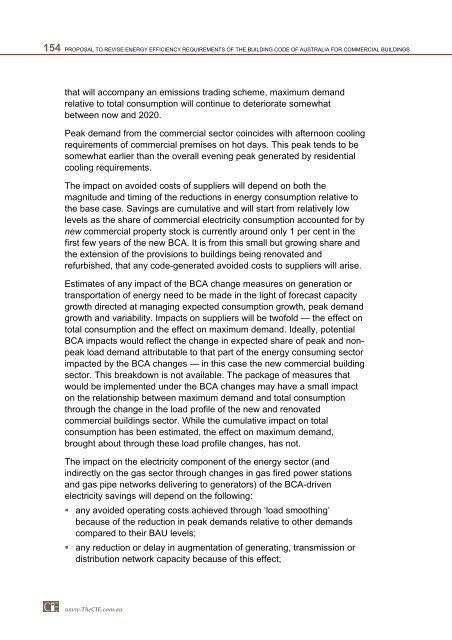PDF | 2 MB - Australian Building Codes Board
PDF | 2 MB - Australian Building Codes Board
PDF | 2 MB - Australian Building Codes Board
Create successful ePaper yourself
Turn your PDF publications into a flip-book with our unique Google optimized e-Paper software.
154 PROPOSAL TO REVISE ENERGY EFFICIENCY REQUIREMENTS OF THE BUILDING CODE OF AUSTRALIA FOR COMMERCIAL BUILDINGS<br />
that will accompany an emissions trading scheme, maximum demand<br />
relative to total consumption will continue to deteriorate somewhat<br />
between now and 2020.<br />
Peak demand from the commercial sector coincides with afternoon cooling<br />
requirements of commercial premises on hot days. This peak tends to be<br />
somewhat earlier than the overall evening peak generated by residential<br />
cooling requirements.<br />
The impact on avoided costs of suppliers will depend on both the<br />
magnitude and timing of the reductions in energy consumption relative to<br />
the base case. Savings are cumulative and will start from relatively low<br />
levels as the share of commercial electricity consumption accounted for by<br />
new commercial property stock is currently around only 1 per cent in the<br />
first few years of the new BCA. It is from this small but growing share and<br />
the extension of the provisions to buildings being renovated and<br />
refurbished, that any code-generated avoided costs to suppliers will arise.<br />
Estimates of any impact of the BCA change measures on generation or<br />
transportation of energy need to be made in the light of forecast capacity<br />
growth directed at managing expected consumption growth, peak demand<br />
growth and variability. Impacts on suppliers will be twofold — the effect on<br />
total consumption and the effect on maximum demand. Ideally, potential<br />
BCA impacts would reflect the change in expected share of peak and nonpeak<br />
load demand attributable to that part of the energy consuming sector<br />
impacted by the BCA changes — in this case the new commercial building<br />
sector. This breakdown is not available. The package of measures that<br />
would be implemented under the BCA changes may have a small impact<br />
on the relationship between maximum demand and total consumption<br />
through the change in the load profile of the new and renovated<br />
commercial buildings sector. While the cumulative impact on total<br />
consumption has been estimated, the effect on maximum demand,<br />
brought about through these load profile changes, has not.<br />
The impact on the electricity component of the energy sector (and<br />
indirectly on the gas sector through changes in gas fired power stations<br />
and gas pipe networks delivering to generators) of the BCA-driven<br />
electricity savings will depend on the following:<br />
• any avoided operating costs achieved through ‘load smoothing’<br />
because of the reduction in peak demands relative to other demands<br />
compared to their BAU levels;<br />
• any reduction or delay in augmentation of generating, transmission or<br />
distribution network capacity because of this effect;<br />
www.TheCIE.com.au
















